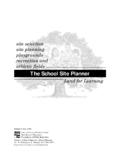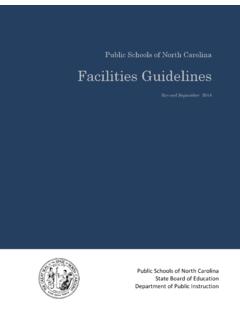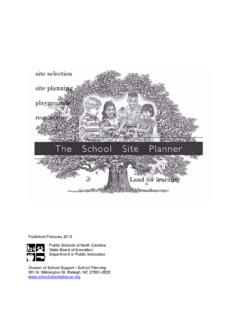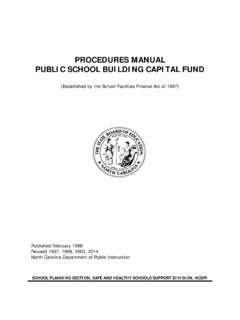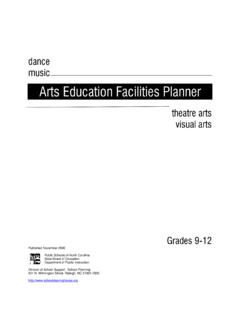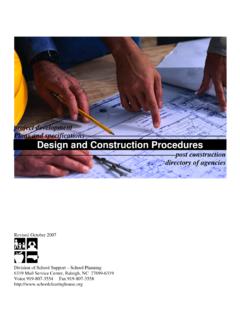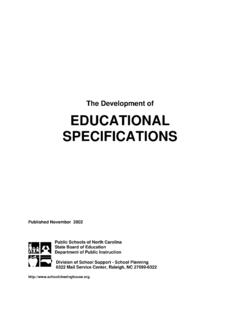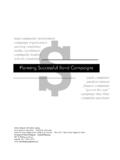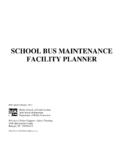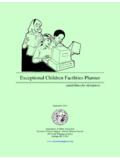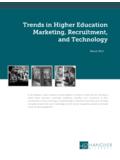Transcription of Making Current Trends in School Design Feasible
1 Small Schools Walkable Schools Urban Schools Making Current Trends in School Design Feasible Smart Growth Joint Use Sustainability Other Design Issues Published November 2000 Public Schools of North Carolina State Board of Education Department of Public Instruction Division of School Support School Planning 301 N. Wilmington Street, Raleigh, NC 27601-2825ii ACKNOWLEDGMENTS The Department of Public Instruction gratefully acknowledges the contributions of the following, without which the development of this publication would have been difficult. LuAnn Bryan, CLP, Consultant, Recreation Resources Service, Parks, Recreation & Tourism Management, NC State University. Susan Chapin, Technology Consultant, Pamlico High School , Pamlico Public Schools. Barbara Collier, Head Media Specialist, Pamlico High School , Pamlico Public Schools.
2 David Edwards, , Education Consultant, School Planning Section, Division of School Support, Department of Public Instruction. Bill Mullin, Director, Facilities Management, Chapel Hill-Carrboro Schools. Larry Philpott, Director, Parks and Recreation Department, County of Cumberland. Steve Taynton, Consulting Architect, School Planning Section, Division of School Support, Department of Public Instruction. Ken Testa, , Learning Director, Clovis High School , Clovis Unified School District, Clovis, CA. In compliance with federal law, including the provisions of Title IX of the Education Amendments of 1972, N C Public Schools administers all state-operated educational programs, employment activities and admissions without discrimination because of race, religion, national or ethnic origin, color, age, military service, disability, or gender, except where exemption is appropriate and allowed by law.
3 Iii FOREWORD The Design of educational facilities has a profound impact upon how students learn and on how well they serve the communities in which they are located. Facilities that strengthen these relationships are often the most successful. Each district, in concert with the needs of its residents, must make many important decisions regarding how, when and where to build and operate its schools. The implementation of many new ideas on the growth of communities and its public facilities is currently taking place. These ideas present exciting times and opportunities. Public School facilities must play an important role in the overall life and growth of communities across North Carolina. This publication describes new and innovative approaches to School facilities, as they relate to their communities.
4 The State Board of Education and the Department of Public Instruction do not necessarily recommend that these approaches should be undertaken. Each local administrative unit should decide what is best for the citizens it serves, as well as the size, location and unique characteristics of the facilities it constructs and operates. This publication is intended as a resource to assist School and Design professionals in planning facilities to meet some of these evolving Trends . We hope you find it useful. Phillip J. Kirk, Jr., Chairman Michael E. Ward, State Superintendent State Board of Education Department of Public Instruction iv v INTRODUCTION Why are so many people talking about returning to smaller schools? During the 1960's, we experienced a movement toward consolidation of small schools in an effort to improve construction and operating economies, reduce administrative staff, and offer more comprehensive educational programs.
5 Those reasons for larger, comprehensive schools still exist today; however, now that we have made this transition, some disadvantages of larger schools have become apparent and the potential advantages of the smaller schools are now being revisited. Specifically, two major Trends are receiving national attention: C There is a widespread belief that small schools may improve student academic performance and enhance School safety, climate and order. The small schools literature began with the large-scale quantitative studies of the late 1980s and early 1990s that firmly established small schools as more productive and effective than large ones. These studies, involving large numbers of students, schools, and districts, confirmed that students learn more and better in small 1 C There is a strong movement and advocacy towards several community planning philosophies called Smart Growth, New Urbanism, Walkable Communities, and other variations.
6 These philosophies promote the use of smaller, community-based and community-shared School facilities. Grassroots activism has begun to influence civic leaders, government entities and other influential bodies in this belief. Such organizations as The Smart Growth Network, New Schools/Better Neighborhoods, Congress for New Urbanism, and others are actively pursuing this philosophy and disseminating information. We anticipate that these Trends will have a significant impact upon the development and use of School facilities in North Carolina and elsewhere. This raises several major questions: C If School leaders, communities and other groups elect to pursue a goal of building smaller schools, what factors should be considered? C If small schools are usually more expensive to construct and operate, how can we improve the economics of constructing and operating them?
7 C How and who should be involved in planning them. This document has been prepared in an effort to answer these questions, provide suggestions and strategies toward Making small schools more economically Feasible , and provide links and references where the concerned official can obtain in-depth material on these subjects. 1 Raywid, Mary Anne Current Literature on Small School ERIC Digest EDO-RC-98-8 (January 1999) vi vii TABLE OF CONTENTS PART I: UNDERSTANDING THE Trends How Big is Small?..3 What is a Walkable School or Community?..3 What is Smart Growth?..4 What is Sustainability?..5 Parallels to Urban PART II: PROS AND CONS OF SMALL SCHOOLS Advantages and Disadvantages of Small and Large Economic Considerations for Small vs.
8 Large PART III: FINDING SOLUTIONS AND APPLYING STRATEGIES Overcoming the Economic Small and Walkable Middle and High Schools: The The Diversity Walkable School Planning for Smart Incorporating Sustainability and Green Building Joint Use Recycling Older, Small Community Small and Urban Site Small Elementary School Building Small Middle School Building Small High School Building Operation Staffing Other REFERENCES FOR FURTHER STUDY Student Achievement Related to School Smart Growth, Community Use, Neighborhood and Walkable viii 1 UNDERSTANDING THE Trends 2 3 How Big is Small? How large is a small School ? How small is a large School ? Much of the research which focuses on student achievement is somewhat conflicting; however, the preponderance of this literature recommends student populations of no less than 300 and no more than 9002.
9 For purposes of this publication, we will define a small School as that indicated by research for effective enhancement of School climate and order which is within the boundaries recommended for enhanced student achievement. On average, this research (Williams, 1990; Howley, 1996) indicates effective [small] School sizes to be: Elementary: 300-400 students Middle: 300-600 students High: 400-800 students For further reading on the subject of School size as related to climate and order, refer to the School Planning Publication: Safe Schools Facility Planner. Other related information and research references are included in the appendix. What is a Walkable School or Walkable Community? Walkable communities are those in which citizens homes and work, children s School , and customary grocery, drug and other stores or services are all within a walkable distance of about a mile.
10 Historically, many older communities developed this way, primarily because the use and ownership of automobiles was limited. Today, many communities are rediscovering the advantages of being walkable and are promoting such development. In addition, numerous new communities are being planned and constructed with many of these elements. Walkable schools in themselves, whether part of a total walkable community or not, are perceived as a highly desirable feature. Campaign speeches, real estate sales advertisements, and residents of communities are frequently espousing the desirability of neighborhood or walkable schools. Due to walking distance limits and the usual housing density found in most of North Carolina s communities, walkable schools are, by their walking distance population, smaller schools.
